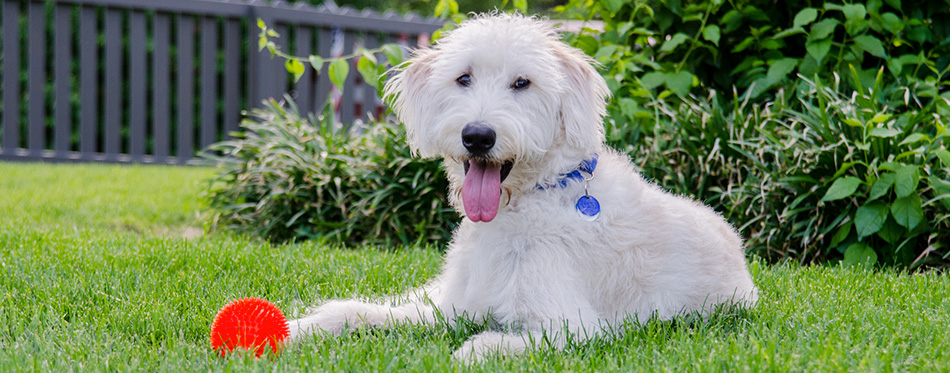As with humans, a dog’s eyes can be a powerful indicator of their health. For this reason, it’s important to look out for any unusual eye symptoms, and report them to your vet if they persist. One of the most common canine eye issues is redness.
When your pooch develops red or bloodshot eyes, this could be a symptom of a few different underlying issues. If you find yourself asking “why are my dog’s eyes red?” read on, as we run through a few of the most common reasons your dog might have red or inflamed eyes.
Why do Dogs’ Eyes Turn Red, and Which Dogs are at Risk?
On a basic level, red eye is caused by the inflammation of blood vessels in your dog’s eye, which can in turn be triggered in a number of ways.
However, unlike humans, dog eyes are protected by a third eyelid, known as the nictitating membrane, which shields the organ against scratches and irritants.
Despite this natural shield, you should bear in mind that certain breeds of dog are more prone to eye problems than others. Brachycephalic (‘flat-faced’) breeds like pugs and bulldogs are more susceptible because of their prominent eyes, while long-haired breeds like the sheepdog, Maltese, or poodle are more prone because irritants can become trapped in the hair around their eyes.

Dry Eye
One of the most common reasons for dog and puppy red eyes is Keratoconjunctivitis sicca – more commonly referred to as ‘dry eye’.
This condition is caused by inadequate tear production. Tears keep the eye well lubricated, and help wash away allergens and harmful bacteria. Without the right amount of tears, the cornea (the outer part of the eye) becomes dry, irritated, and inflamed.
A dog can develop dry eye for a few reasons – most commonly immune-mediated adenitis. This condition damages the tissue that usually produces the watery part of tears. Treatment for dry eye usually involves the use of artificial tears to compensate for this damaged tissue.
Cherry Eye
Another condition that causes red eye in dogs is cherry eye. This occurs when a dog’s third eyelid, which usually remains hidden, pops out of place and appears as a red sphere in the corner of the eye.
The condition is called ‘cherry eye’ because this displaced eyelid resembles a cherry. Certain dogs are more prone to cherry eye than others. The condition is caused by a genetic disorder, which results in the ligaments that usually hold the third eyelid in place being weakened.
Treatment for cherry eye is typically surgical. Your vet will use a procedure to secure the eyelid in its usual position to prevent it from popping out of place again. Unfortunately, cherry eye can sometimes relapse, so it’s important to keep an eye on your pet even months or years after their surgery.
Pink Eye
Just like humans, dogs can suffer from an eye condition called conjunctivitis or, colloquially, ‘pink eye’. This condition occurs when a dog’s conjunctiva – the pink, wet tissue lining the inner eyelids and the front of the eyes – becomes inflamed.
Pink eye can arise as the result of a few different triggers, such as contact with irritants, and bacterial infection.
Treatment for your dog’s pink eye will depend on what the underlying cause of the condition is. Infections will be treated with a course of antibiotics, while allergies may be treated with lifestyle changes and antihistamines. If the pink eye is caused by an irritant in the eye, your vet will most likely recommend regular eye baths and potentially soothing drops while the eye heals itself.
Cornea Damage
General damage to the outside surface of the eye can also result in inflammation and redness. This damage could come from a variety of sources – perhaps your dog has run through a thicket and a twig has scratched their eye, for example.
Although this redness can be uncomfortable, in most cases you can expect your dog’s eye to begin healing itself. If the redness does not subside in a few days, though, you should take your dog to the vet in order to determine whether the scratch is more serious, or has become infected.
Other Symptoms to Watch Out for
Along with redness, there are a few other eye symptoms that owners should be aware of:
- Unusual discharge – this can be a sign of infection.
- Excessive blinking – this suggests that the eye is irritated.
- Foreign objects lodged in the eye – if you notice this, take your dog to the vet immediately. The sooner the object is removed, the less damage it can inflict.
- Increased eye watering.
- Visible scratches to the cornea.
- Eye rubbing – this also suggests irritation.

Looking After Your Dog’s Eyes
If you suddenly notice: “my dog’s eye is red!” it can be easy to panic. However, the majority of underlying causes are easily treatable, and with a little patience and the right medicine your pet’s eyes will quickly return to normal.
When you visit your vet with a dog that has bloodshot eyes, you can expect them to conduct a thorough eye exam. This will involve inspecting the surface of each eye carefully, and possibly using brightly colored drops to identify any scars or scratches to the cornea.
Treatment will depend upon the result of this exam. For instance, infections will be treated with antibiotics, and dry eye will be treated with drops to stimulate tear production.
There are also a few steps you can take to promote better eye health in the future:
- Keep the hair around your dog’s eyes short and neat, to prevent allergens or bacteria from becoming trapped
- Carefully wipe away ‘gunk’ and dirt from your dog’s eyes regularly. For more options, check out our detailed review of dog wipes.
- If your vet recommends it, use a dog-friendly eye-wash regularly
Source:
- Examining and Medicating the Eyes of a Dog – Washington State University
- Dog Eye Infections – AKC

